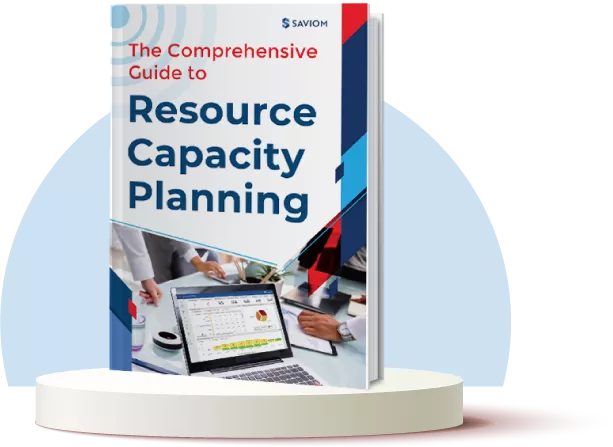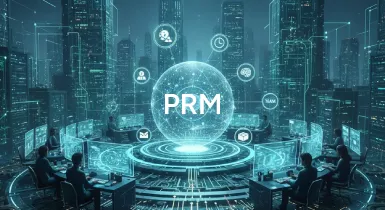If you think of a project as a journey, then deliverables are your destination. Whether it is a software, website, marketing campaign, or internal process overhaul, project deliverables are the final outcomes that define success. They provide structure, clarity, and direction throughout the entire project lifecycle.
Understanding and managing deliverables effectively ensures that projects align with their goals, are completed on a pre-defined timeline, and meet stakeholder expectations. They also help managers to plan, track, and measure project progress with greater accuracy.
On the other hand, if deliverables are poorly managed, it can cause schedule overruns, substandard output, and even project failure. That’s why it is necessary to manage project deliverables efficiently.
In this blog, we will learn everything about what are project deliverables, their importance, and the top 6 ways to manage them effectively.
Let’s start!
What are Project Deliverables?
Project deliverables are the final tangible or intangible outcomes of a project. They can include products, reports, or services as outlined in the project scope. These deliverables are agreed upon by stakeholders at the project onset, and therefore, they are the benchmark against which success is measured. The number of deliverables in a project varies depending on the customer’s specific requirements.
Project deliverables are specific, measurable, and time-bound, which means they are expected to be delivered within the specified timeline and meet pre-determined quality standards. When defined clearly in the planning phase, they enable managers to effectively prioritize tasks, manage resources, and resolve bottlenecks in the later stages of the project lifecycle.
Now, let us see who is responsible for managing these deliverables.
Who is Responsible for Managing Project Deliverables?
When it comes to managing deliverables, the primary responsibility lies with the project manager. However, they are not accountable alone. While they are responsible for clearly defining the deliverables, coordinating with teams, and assigning and monitoring tasks, other project team members also play a key role.
Team members with different roles are responsible for executing the assigned deliverables. Next, the team lead is responsible for monitoring the proper execution of each task. Lastly, project stakeholders also play a crucial role as they validate and accept the final outputs. Therefore, it is a combined team effort that leads to the successful delivery of project outcomes.
What Documents Help Define Project Deliverables?
Every project – from initiation to completion – comprises several documents. The following play a crucial role in defining project deliverables:
Project Charter
A project charter is a document that formally authorizes a project. It outlines every critical detail of a project, including objectives, scope, deliverables, etc. This document also defines the roles and responsibilities of the project team and mentions a high-level budget and schedule.
Project Scope Statement
The project scope statement is an essential document that outlines what is included and what is not included within the project boundaries. It explains the deliverables in detail and is reviewed and approved by stakeholders. This document helps managers prevent confusion in the later stages of the project.
Work Breakdown Structure
A work breakdown structure (WBS) allows project managers to decompose the project into tasks, subtasks, and work packages. This allows managers to visualize the deliverables at a granular level. As a result, they can closely track the progress of each deliverable and make better decisions.
Read More: How to Build a Work Breakdown Structure? A Step-by-Step Guide
So far, we have understood the meaning of deliverables in project management and what documents are required to define them. Let us now explore the different types of project deliverables.
Types of Project Deliverables
A project can have different types and forms of deliverables based on objectives and requirements. To understand them better, here is a precise classification:
Product Deliverables
Product deliverables are the final output of any project, as outlined in the scope statement. They are the ultimate goal that project teams work to achieve, and they directly satisfy the client’s requirements. Examples include a live website, a software application, a training manual, or any finished product that stakeholders can assess.
Process Deliverables
Process deliverables are the intermediate outputs produced during the project execution phase. They don’t satisfy customer requirements directly but help move the project forward and contribute to the final deliverables. Examples include test reports, prototypes, project milestones, etc.
Internal Deliverables
Internal deliverables are created for in-house use to help project teams manage work efficiently. They are reviewed within the company, enabling teams to track progress closely, avoid discrepancies, and ensure the project doesn’t derail. Examples include a project plan, status report, initial design, risk assessments, etc.
Read More: What is a Project Plan & How to Create an Effective One?
External Deliverables
External deliverables are the final results delivered to external stakeholders or clients. They are produced to undergo final client reviews based on which a project’s success or failure is decided. Examples include final products, marketing campaigns, a new training program, etc.
Tangible Deliverables
Tangible deliverables are the quantifiable or physical outputs that are produced during a project. They can be physical or digital in nature, allowing stakeholders and clients to easily assess their quality and mark the completion of a project. Examples include equipment, software, reports, hardware, etc.
Intangible Deliverables
In contrast to tangible deliverables, intangible deliverables are the non-physical outputs of a project. They cannot be seen, touched, or used, but they still play a crucial role in a project’s successful completion, which makes them valuable. Examples include a new business process, improved strategies, workflow updates, etc.
Read More: 12 Key Project Reports for Successful Project Managers
Moving on, let’s understand the types of project deliverables with detailed examples.
Project Deliverables Examples
To understand the types of project deliverables better, let us take the example of a website development project for a retail company.
The client’s requirement is to build a fully functional eCommerce website that would allow customers to browse products, add items to the cart, and complete purchases securely. Based on this, here’s how the deliverables are defined:
- Product Deliverable: The fully developed functional eCommerce website with all the required features, such as product listing, payment integration, etc., that directly fulfill the project’s objectives.
- Process Deliverables: To guide developers and ensure consistency, the team creates a UI/UX design document that outlines the website’s layout, mobile responsiveness, etc.
- Internal Deliverables: During the project planning stage, the development team prepares a technical feasibility report to identify potential bottlenecks and assess tool compatibility. It is never shared with the client, but it allows the team to ensure project completion successfully.
- External Deliverables: The final website link that is shared with the client for review, feedback, and approval before the live launch.
- Tangible Deliverables: The physical or digital outputs of the project, such as source code files, design assets, etc., which are handed over to the stakeholders at the end of the project.
- Intangible Deliverables: Along with the tangible outputs, the project also helped improve team collaboration, refine coding practices, etc. These outcomes add strategic value even though they weren’t the core goals of the project.
Read More: 10 Ways to Improve Cross-Departmental Collaboration
Now, let us understand the difference between project deliverables and project milestones.
Project Deliverable vs. Project Milestone
Project deliverables can often be confused with project milestones. Therefore, it is crucial to establish their differences. The following table provides a clear distinction between them:
| Aspect | Project Deliverables | Project Milestones |
|---|---|---|
| Definition | Tangible or intangible outputs of a project | Significant events in a project |
| Nature | Result-oriented | Time or event-oriented |
| Purpose | Fulfill project objectives | Track project progress |
| Measurement | Measured by quality and completeness | Measured by time or phase completion |
| Stakeholder Involvement | Evaluated by internal or external stakeholders | Reviewed mainly by project teams or sponsors |
| Impact | Directly influences project success | Helps monitor and control project timelines |
Read More: Project Milestones: How to Manage Them Effectively for Project Success?
Having understood the differences between project deliverables and milestones, let us now understand why deliverables in project management are essential.
Importance of Project Deliverables
As we all know, project deliverables are necessary for successful completion. However, deliverables in project management are important for several other reasons, including:
- Deliverables clearly define the project requirements from the outset, eliminating any confusion that may delay the project.
- They ensure that every individual in the team understands the project objectives and goals that need to be achieved.
- Project management deliverables often act as milestones, helping managers track progress and identify the completion of important phases.
- They help managers ensure that the project remains within the boundaries of its approved schedule and project budget.
- Project deliverables ensure all stakeholders are on the same page by facilitating open communication in the early stages.
- Lastly, they provide measurable outputs that can be assessed, helping stakeholders to evaluate project performance accurately.
Having explored the importance of project deliverables, let us now take a look at the roadblocks faced while managing these deliverables.
Challenges in Managing Project Deliverables
Listed below are some of the most common challenges of deliverables in project management:
Unclear Project Scope & Requirements
If the project scope and requirements are not defined clearly, it can lead to confusion and uncertainty in the team regarding the deliverables and their timelines. This often leads to misaligned efforts and increased rework. Consequently, managers struggle to produce the expected quality of outcome.
Read More: What is a Project Scope? Benefits, Best Practices, and Steps to Create an Effective One
Misalignment with Stakeholder Expectations
Project stakeholders are responsible for defining deliverables to help managers avoid any uncertainty around expectations. However, sometimes misalignment occurs when the requirements are not communicated properly or misunderstood by the project team. In these cases, the project fails to meet its original objectives, and stakeholders remain unsatisfied. This results in costly rework, delays, or worse – project failure.
Scope Creep
As per PMI’s survey, “52% of projects suffer scope creep.”
This highlights that scope creep is a common pitfall that happens due to new or altered expectations midway. These unexpected changes can disrupt the established project workflow and stretch the timeline. Moreover, the increased complexity often leads to compromised quality, ultimately affecting final deliverables.
Read More: 7 Effective Strategies to Avoid Scope Creep in Project Management
Quality Control Issues
In the absence of quality assurance processes, deliverables fail to meet pre-defined standards. This gives rise to issues such as incomplete features, technical errors, or inconsistent documentation that doesn’t align with stakeholder expectations. When quality issues go unnoticed, stakeholders may reject the deliverables, leading to wasted effort and project delays.
Resource Constraints
Resources are the backbone of any project, and ignoring constraints related to them, such as resource unavailability, skill gaps, or unplanned attrition, can significantly lead to project failure. Therefore, inefficiency in tackling these constraints poses another challenge in managing deliverables because it can hinder the project’s timely completion and expected quality.
Read More: What are Resource Constraints, and How Does It Affect Project Success?
Unrealistic Deadlines
According to a PMI survey, “26% of projects fail due to inaccurate time estimates.”
This statistic highlights that setting unrealistic or inaccurate deadlines can lead to project failure. When teams are expected to hand over specific project deliverables within a tight deadline, critical steps get overlooked, and attention to detail is compromised. This affects the quality of final deliverables and sometimes even puts overall project success at risk.
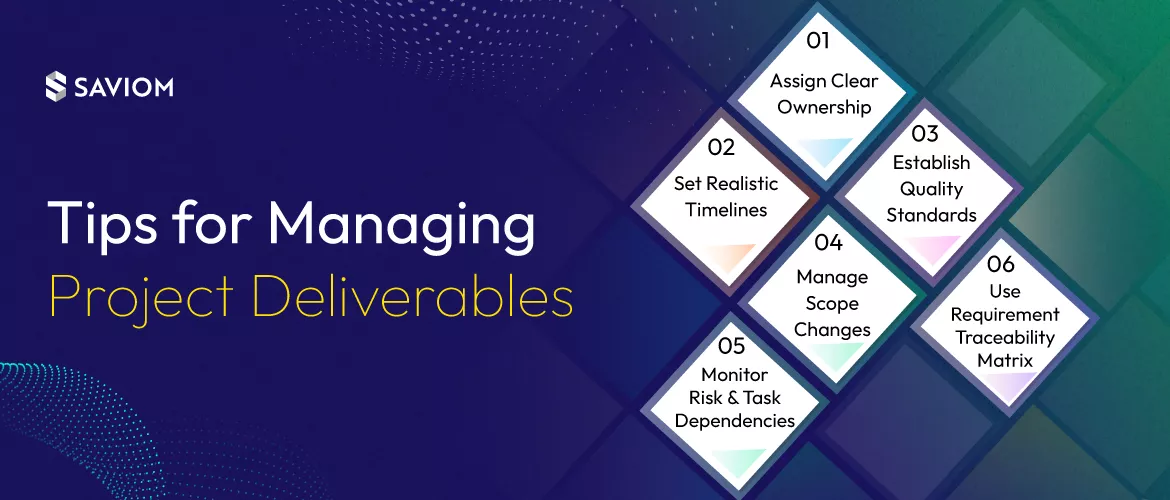
When exploring what are deliverables in a project, it is crucial to understand how to identify them.
How to Identify Project Deliverables?
Here is how you can identify the project deliverables effectively:
Define Project Scope & Objectives
The very first step to accurately identifying deliverables is defining the project’s scope and objectives. These attributes outline the project’s boundaries, tasks, deadlines, etc., and help the team understand what exactly is expected from them. A well-defined scope not only guides managers in identifying project deliverables but also helps them avoid mistakes and minimize scope creep by setting clear limits from the outset.
Understand Stakeholders’ Expectations
Secondly, managers need to have a clear dialogue with the project stakeholders about their expectations and needs. This prevents misalignment and reduces the probability of rework, ensuring that the project meets quality standards. Additionally, gathering input from stakeholders early helps align deliverables with their vision, resulting in fewer approval hassles and faster project delivery.
Read More: Who are Project Stakeholders? 7 Effective Ways to Manage Them
Break Down the Scope into Tangible Output
The third step is decomposing the project scope into more manageable tasks or tangible outputs. This can be done effectively using a work breakdown structure (WBS), which helps managers decompose a project into tasks, sub-tasks, and work packages. It provides clarity on different completion items that contribute to the final deliverables. Beyond that, it makes dependencies more visible and prevents the risk of overlooking key elements.
Identify & Define Specific Deliverables
Once a project has been broken down into smaller components, a manager can identify and define the individual deliverables at each stage. Accordingly, they can categorize them into various types: product, process, tangible, or intangible deliverables. This helps bring clarity to what needs to be delivered at which project phase and enables better planning and performance tracking.
Read More: 9 Effective Tips on Enhancing Employee Performance at Work
Establish Clear Acceptance Criteria
For any project to be considered successful, it is vital that the deliverables meet well-defined acceptance standards. That’s why the managers must collaborate with stakeholders to establish specific and measurable quality benchmarks and acceptance criteria. This step ensures that all deliverables are evaluated consistently and approved without any rework.
Validate Deliverables Against Project Requirements
The next step is validating the deliverables against the project requirements specified in the scope statement. This helps managers ensure they haven’t overlooked any deliverables, allowing them to take corrective actions beforehand. It also aids in identifying any discrepancies, gaps, or potential deviations early in the process.
Read More: 7 Essential Steps of Project Integration Management: A Complete Guide
Document Deliverables & Assign Ownership
After identifying and validating the deliverables, managers can document them clearly, along with their specifications. This documentation should be shared among all the stakeholders as it provides a single point of reference for the project team. It is also important to assign clear ownership for each deliverable to ensure accountability and transparent communication, avoid confusion, and facilitate timely completion.
Gain Client Approval & Confirm Deliverables
Lastly, managers should get the identified deliverables confirmed and agreed upon by the relevant project stakeholders. This ensures that the project deliverables are fully in line with what the stakeholders require. Besides, getting an official agreement confirms there are no misunderstandings, and the team can start working on the deliverables and completing them within the estimated time.
Read More: What is Project Duration? 7 Effective Ways to Estimate It Accurately
Now that we have learned how to identify deliverables in project management, let us move on to understanding how to manage them.
Tips for Managing Project Deliverables
After identifying project deliverables, managing them effectively ensures everything is delivered as per requirements. Following are some tips to manage project management deliverables:
Assign Clear Ownership
The first step is to assign ownership of the deliverables, which can be done at different levels – from specific tasks to an entire project. This helps managers ensure that deliverables are assigned to people with relevant skill sets, which eliminates confusion and streamlines the workflow. It also gives visibility into who is responsible for completing and reviewing each deliverable, ultimately promoting accountability among team members.
In addition, assigning ownership facilitates timely communication, allowing managers to address issues and avoid last-minute delays proactively. For example, assigning the content deliverable to a copywriter and the design asset to a graphic designer in a marketing project ensures the right expert handles each output. This division enhances quality and streamlines the review process.
Set Realistic Timelines
Every task in a project must be completed within a particular timeline. When it stretches, the whole project schedule can be derailed. This can result in stakeholder dissatisfaction and budget overruns. Therefore, to set realistic timelines, managers can estimate the time each task (as defined in the WBS) might take. They should also consider some buffer time in case any rework happens.
Additionally, when setting timelines, it is important to involve stakeholders and other team members to gather their input. Managers should also update the timelines in case requirements change or unforeseen projects or resource risks arise. This collaborative and flexible approach ensures that deadlines remain achievable and deliverables are completed without overburdening the team.
Read More: What Are Resource Risks in Project Management & How to Mitigate Them?
Establish Quality Standards
As discussed earlier, establishing quality standards is vital as they help decide a project’s success. These benchmarks should align with stakeholder expectations and project objectives while adhering to SMART (Specific, Measurable, Achievable, Relevant, and Time-bound) attributes. This approach ensures clarity around what constitutes quality and helps teams work toward well-defined, realistic targets.
To implement this effectively, project managers can define relevant quality metrics and set up periodic checks. Additionally, using feedback loops helps managers identify issues early and take necessary corrective actions. This proactive approach allows teams to maintain consistency and ensure the final output meets the pre-defined quality benchmarks.
Manage Scope Changes
Project requirements can evolve with changing stakeholder expectations, which can subsequently lead to modifications in the final deliverables. To prevent scope creep, it is essential to have a clearly defined scope baseline from the project’s onset. It enables teams to prevent deviations and guarantees that the project deliverables meet stakeholders’ expectations.
Moreover, managers must establish a robust change control process where new requirements are thoroughly reviewed before being approved or rejected. This allows managers to ensure transparent communication with stakeholders regarding scope changes and their possible impact. When done correctly, deliverables remain on track and aligned with the agreed-upon goals.
Read More: What is Change Management in Project Management, and Why Is It Important?
Monitor Risk & Task Dependencies
Project deliverables are hugely affected by potential risks such as resource shortages, technical failure, or supply chain disruptions. Managers can use a risk matrix or risk register to identify, categorize, and mitigate them. These tools allow teams to prevent risks or minimize their impact and ensure project deliverables are completed on time.
Similarly, task dependencies also impact project deliverables. When one task is delayed, it can cause a chain reaction and derail the entire project’s progress. Therefore, it is important for managers to monitor task dependencies regularly using tools such as Gantt Charts. This prevents schedule overruns and ensures timely project delivery.
Use Requirement Traceability Matrix
The Requirement Traceability Matrix (RTM) is a tool that helps managers track every project requirement to its origin. This makes it easier for managers to map deliverables and other project artifacts in detail. As a result, they get better control over the project, eliminate the risk of overlooking any deliverables, and improve alignment with overall objectives.
RTM also helps improve the change management process by simplifying the impact assessment of new requirements on the existing project timeline, budget, or other aspects. In addition, RTM can be mutually shared among stakeholders and team members to eliminate communication gaps and confusion regarding deliverables. This ultimately helps streamline the deliverables and keep the entire project on track.
Read More: Requirement Traceability Matrix: Definition, Types & Its Significance in Project Management
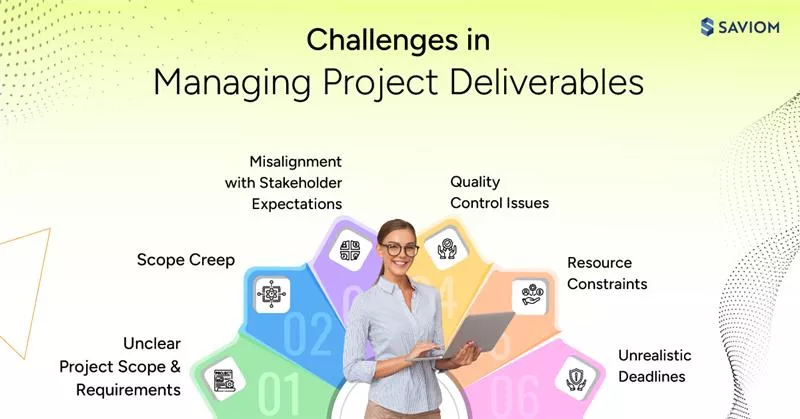
Now that we have learned how to manage deliverables in project management effectively, let us see how an advanced project resource management tool can help this process.
How Can a Resource Management Tool Help You Manage Project Deliverables?
Leveraging advanced resource management software can simplify the process of identifying and managing project deliverables. Here is how it helps:
- The tool’s all-in-one resource planner provides a centralized platform to filter resource data according to customized dimensions like role, location, cost, etc. Based on this, managers can make better resourcing decisions that help successfully complete project deliverables.
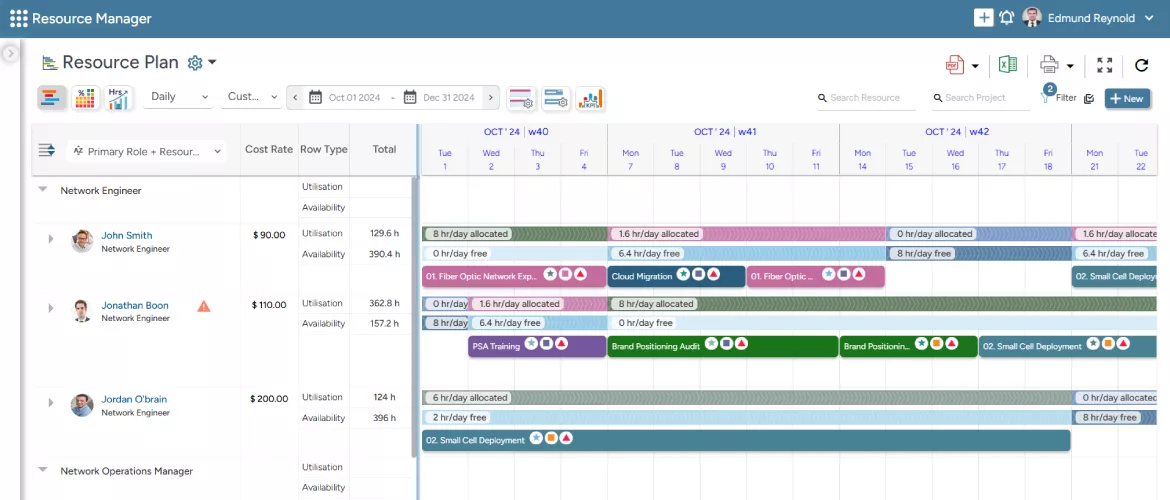
SAVIOM’s All-in-One Resource Planner offers a centralized platform to manage enterprise-wide resources, enabling real-time visibility into allocations, availability, and project demands.
- With the embedded capacity planner, managers can foresee any resource shortages/excesses, which helps them analyze if deliverables can be achieved with the available resources. If not, timely resourcing treatments can be taken to avoid last-minute firefighting.
- The embedded heat mapping facility allows managers to track the allocation and overutilization of resources. Based on this assessment, they can adjust workloads to ensure project deliverables are completed without overburdening the team.
- The tool comes equipped with an intelligent matchmaking system that helps managers find the best-fit resource to work on a deliverable based on skill set, experience, competencies, etc. This ensures that only competent resources are assigned to tasks.
- Next comes the early warning system, which managers can use to avoid resource booking conflicts like double bookings, overloading, etc. The early warnings offer ample time to take corrective measures so that project deliverables are not affected.
- Lastly, the smart KPI forecaster helps managers forecast any upcoming resource shortages, excesses, availability, utilization, etc. This facilitates data-driven decision-making, which allows managers to ensure the seamless completion of deliverables.
2. Detailed tasks and time management allow managers to monitor the status of each deliverable. They can easily assess how much time resources take to complete deliverables. Based on this, they can adjust timelines if needed and ensure no deliverables are delayed.
3. Next comes the Gantt chart, which provides complete visibility of project tasks, subtasks, milestones, interdependencies, etc. Using this, managers can manage task dependencies better and track project progress in real-time.

SAVIOM’s Gantt Chart allows managers to view all task dependencies on a single screen, helping them track project progress in real-time.
4. Finally, with the what-if analysis feature, managers can simulate various scenarios, which helps them analyze the impact of changes on the project deliverables. Based on this, they can make informed decisions before harming the project timelines, schedule, or budget.
Final Thoughts
Deliverables define project success, so it is of utmost importance to identify and manage them efficiently. Inefficiencies in this aspect can lead to project failure, stakeholder dissatisfaction, revenue loss, and reduced client retention. While managing deliverables comes with its own set of challenges, using an advanced tool can significantly simplify this process.
Are you currently using any tools to manage project deliverables?
The Glossary
Read More: Glossary of Resource Workforce Planning, Scheduling and Management




